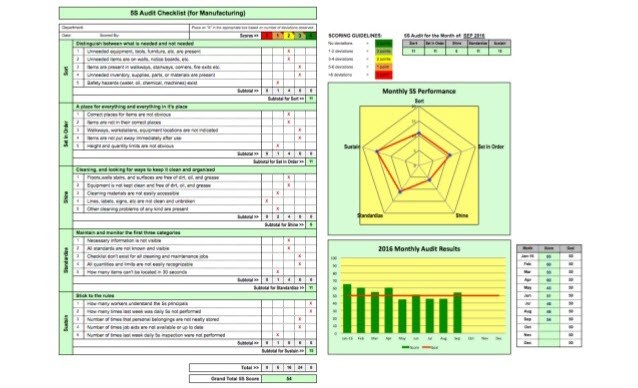The 5S practice is a technique used to establish and maintain quality environment in an organization. The original concept was developed by Osada in the early 1980s. The acronym 5S stands for the five Japanese words seiri (organization), seiton (neatness), seiso (cleanliness), seiketsu (standardization), and shitsuke (discipline). These techniques were first discovered by researchers studying the secrets of Japanese manufacturing success. Factories were so organized that unwanted activities can be detected. Equipment were so clean and maintained that the slightest leakage of oil or loose bolts is noticed. Cleanliness and orderliness became a lifestyle in the organizations. These became effective due to different types of waste as defects, overproduction, over processing, inventories, transport, motion, waiting and untapped resources.
The 5 S’es
First on the lists is the Seiri which is also known as Organization. This requires the ability of deciding what you need, removal of unnecessary clutter, proper storage of tools and materials, and removal of unwanted or broken materials in the manufacturing sector. The Second one is Seiton which means Neatness. This requires the elimination of unwanted items, return of left over items, organized layout of tools and equipment to designated locations using proper labelling and everything is available as at when needed. The third one is Seiso which means Cleanliness. This requires creating a spotless workplace, identifying and eliminating causes of dirt and grime, and defining responsibility for cleaning at all times. The forth one is Seiketsu which means Standardization. This requires generating a maintenance system, developing procedures, schedules and practices, regulating the use of 5S checklists and measures of housekeeping. The last on the list is Shitsuke which means Discipline. This entails inoculate courtesy and good habits, proactive approach towards making it a way of life and part of health and safety culture.
5s Checklist for Manufacturing
In a manufacturing environment, generating the 5S in practice can bring in results that could considerably raise the environmental performance in line with the improved housekeeping and health & safety. Generating the 5S checklist for manufacturing prior to auditing comes in different forms. There are a total of 25 evaluation criteria covering the 5S principles. Such criteria requires to perform work up-to-date and length of time the inventory, materials in queue in the area covering the principles of sorting, straighten, shine, standardize and sustain are classified under the items found in the manufacturing environment like furniture (bench/table, desk, chairs, cabinets, etc.), machinery, equipment, tools, storage areas, uncluttered with no unnecessary items, documents and boards. Because the 5S Methodology relies on organized, standard practices and processes to improve and sustain quality in production, the 5S checklist for manufacturing divides each of the housekeeping stages that are graded from zero to four, with zero being unacceptable and four meaning outstanding or perfect.
Example of 5s Checklist for Manufacturing
Below is an example on how to generate a 5S checklist for manufacturing. First column lists action items. Column headings include the five housekeeping items of 5S, sort, straighten, shine, standardize, and sustain. For each action item, the auditor who analyses the process can grade each item to determine a score. In this 5S checklist for manufacturing, a perfect score would be 100 (25 questions x 4 points) if all action items were given the highest mark of a four.
Each criteria is evaluated against a five-point scale:
- 4 points = No deviations
- 3 points = 1-2 deviations
- 2 points = 3-4 deviations
- 1 point = 5-6 deviations
- 0 point = >6 deviations
The possible score is organized into five scoring bands:
- 81-100: Excellent
- 61-80: Good
- 41-60: Fair
- 21-40: Poor
- 1-20: Very Poor
This 5S audit worksheet can be applied generally to all manufacturing departments. You may change the audit criteria to suit your specific environment. With the 5S checklist for manufacturing, you can instantly view your monthly 5S audit results visually with a Radar Chart and a Monthly Trend Chart. A substandard 5S process would show a much lower score. However, because the 5S audit check quickly identifies the areas that need improvement, the 5S auditor can pass on the information to the 5S leader, usually top management.
Upon receipt of the 5S audit check sheet, the leaders of the process are then able to determine if additional steps, tools or methods are needed to sustain the production process.
Conclusion
Generating 5S practice in theory involves straightforward steps which lead to continuous improvements. 5S is a Lean technique that involves activities designed to create and maintain a disciplined workplace. It helps create a better working environment and can be implemented to eliminate waste and improve operational processes. The performance of 5S in a workplace could be evaluated using a 5S Checklist, which is a tool that will help ensuring that 5S standards and workplace organization are being met. It enables the observer to better address compliance gaps and provides an opportunity for continuous improvement.






